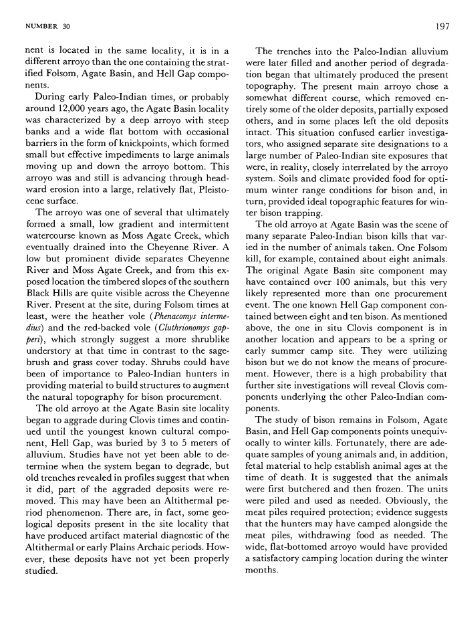Plains Indian Studies - Smithsonian Institution Libraries
Plains Indian Studies - Smithsonian Institution Libraries
Plains Indian Studies - Smithsonian Institution Libraries
You also want an ePaper? Increase the reach of your titles
YUMPU automatically turns print PDFs into web optimized ePapers that Google loves.
NUMBER 30 197<br />
nent is located in the same locality, it is in a<br />
different arroyo than the one containing the stratified<br />
Polsom, Agate Basin, and Hell Gap components.<br />
During early Paleo-<strong>Indian</strong> times, or probably<br />
around 12,000 years ago, the Agate Basin locality<br />
was characterized by a deep arroyo with steep<br />
banks and a wide flat bottom with occasional<br />
barriers in the form of knickpoints, which formed<br />
small but effective impediments to large animals<br />
moving up and down the arroyo bottom. This<br />
arroyo was and still is advancing through headward<br />
erosion into a large, relatively flat. Pleistocene<br />
surface.<br />
The arroyo was one of several that ultimately<br />
formed a small, low gradient and intermittent<br />
watercourse known as Moss Agate Creek, which<br />
eventually drained into the Cheyenne River. A<br />
low but prominent divide separates Cheyenne<br />
River and Moss Agate Creek, and from this exposed<br />
location the timbered slopes of the southern<br />
Black Hills are quite visible across the Cheyenne<br />
River. Present at the site, during Polsom times at<br />
least, were the heather vole {Phenacomys intermedius)<br />
and the red-backed vole {Cluthrionomys gapperi),<br />
which strongly suggest a more shrublike<br />
understory at that time in contrast to the sagebrush<br />
and grass cover today. Shrubs could have<br />
been of importance to Paleo-<strong>Indian</strong> hunters in<br />
providing material to build structures to augment<br />
the natural topography for bison procurement.<br />
The old arroyo at the Agate Basin site locality<br />
began to aggrade during Clovis times and continued<br />
until the youngest known cultural component.<br />
Hell Gap, was buried by 3 to 5 meters of<br />
alluvium. <strong>Studies</strong> have not yet been able to determine<br />
when the system began to degrade, but<br />
old trenches revealed in profiles suggest that when<br />
it did, part of the aggraded deposits were removed.<br />
This may have been an Altithermal period<br />
phenomenon. There are, in fact, some geological<br />
deposits present in the site locality that<br />
have produced artifact material diagnostic of the<br />
Altithermal or early <strong>Plains</strong> Archaic periods. However,<br />
these deposits have not yet been properly<br />
studied.<br />
The trenches into the Paleo-<strong>Indian</strong> alluvium<br />
were later filled and another period of degradation<br />
began that ultimately produced the present<br />
topography. The present main arroyo chose a<br />
somewhat different course, which removed entirely<br />
some of the older deposits, partially exposed<br />
others, and in some places left the old deposits<br />
intact. This situation confused earlier investigators,<br />
who assigned separate site designations to a<br />
large number of Paleo-<strong>Indian</strong> site exposures that<br />
were, in reality, closely interrelated by the arroyo<br />
system. Soils and climate provided food for optimum<br />
winter range conditions for bison and, in<br />
turn, provided ideal topographic features for winter<br />
bison trapping.<br />
The old arroyo at Agate Basin was the scene of<br />
many separate Paleo-<strong>Indian</strong> bison kills that varied<br />
in the number of animals taken. One Polsom<br />
kill, for example, contained about eight animals.<br />
The original Agate Basin site component may<br />
have contained over 100 animals, but this very<br />
likely represented more than one procurement<br />
event. The one known Hell Gap component contained<br />
between eight and ten bison. As mentioned<br />
above, the one in situ Clovis component is in<br />
another location and appears to be a spring or<br />
early summer camp site. They were utilizing<br />
bison but we do not know the means of procurement.<br />
However, there is a high probability that<br />
further site investigations will reveal Clovis components<br />
underlying the other Paleo-<strong>Indian</strong> components.<br />
The study of bison remains in Polsom, Agate<br />
Basin, and Hell Gap components points unequivocally<br />
to winter kills. Fortunately, there are adequate<br />
samples of young animals and, in addition,<br />
fetal material to help establish animal ages at the<br />
time of death. It is suggested that the animals<br />
were first butchered and then frozen. The units<br />
were piled and used as needed. Obviously, the<br />
meat piles required protection; evidence suggests<br />
that the hunters may have camped alongside the<br />
meat piles, withdrawing food as needed. The<br />
wide, flat-bottomed arroyo would have provided<br />
a satisfactory camping location during the winter<br />
months.

















